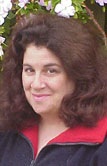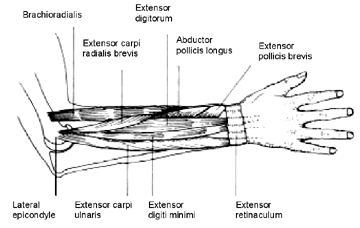June 2002 Article Tennis Server
|

 |
During the month of May, several people participated in a discussion on tennis elbow at "Tennisbiz," Tennis Server's tennis business discussion forum. If you are not a member of the forum, you can subscribe at http://www.tennisserver.com/tennisbiz. (Anyone can use its search engine to read the tennis elbow or other past discussions on the forum. Place "tennis elbow" in the search.) There were a lot of questions and discussion regarding the causes, incidence of injury (injury rate of occurrence) and treatment of the condition. Having just finished some work with my colleague, Dr. Alison Cooke on the possible relationship between tennis racquet design and the prevalence of arm injuries, I thought I would share some of the published research on the subject. First, a little background: in 2000, the International Tennis Federation (ITF) commissioned a study with Cambridge University (United Kingdom) to determine the correlation between racquet design and arm injuries. At that time, Dr. Alison Cooke was the director of sports engineering at Cambridge and led the project. The group's objectives were to determine:
Cooke and her associates approached the task by modeling the problem and defining a list of potential factors which included:
As you've recognized this is a pretty tall order! Last month I mentioned the 2000 ITF Tennis Science and Technology Congress. Conducted in late July/early August, 2000, the two hot topics were: 1) the bigger ball; and 2) the lack of a comprehensive injury database for tennis players. The latter has made it difficult to quantify, track and understand these types of injuries. Yet without this specific information, efforts to alleviate tennis elbow through changes in racquet design may only be based on speculation versus accurate information. Clearly this is a broad subject which crosses physical and life science disciplines as well as engineering. The original report to the ITF was quite long, subsequently this article will be in two parts. So this month we'll look at an overview of tennis elbow and clinical/sports medicine aspects. Next month we'll summarize the physical mechanics of the racquet and racquet grip and examine the gaps in knowledge.
Let's begin by defining "tennis elbow."
Lateral Epicondylitis:
Dr. Marc Safran, an orthopaedic surgeon and co-director of Sports Medicine at the University of California, San Francisco writes and lectures extensively on tennis injury. He added, "... only 5 - 10% of those seeking treatment for tennis elbow actually play tennis. While in the general population, epicondylitis affects the lateral side 7 times more commonly than the medial side, professional tennis players actually suffer from medial epicondylitis more often than lateral epicondylitis. With that being said, the prevalence of tennis elbow is estimated at 40 - 50% of tennis players, especially those over 30 years old."
According to Roetert, et al., (1995), Runge first described lateral epicondylitis in 1873. Lateral epicondylitis occurs not only in sports but also is common among carpenters, musicians and other physical activities such as baggage handling, longhand writing and shaking hands. The main symptom of lateral epicondylitis is physical discomfort, from a mild ache to a severe pain, usually aggravated by gripping with or twisting the wrist. The grip can be weak and there can be tenderness at the elbow. Playing tennis aggravates the pain, and often playing may need to be temporarily discontinued. Diagnosis by a clinician is generally straightforward with no special tests required, although other conditions can produce similar symptoms. Speed (2000) and Roetert, et al., (1995) noted lateral epicondylitis affects 40-50% of recreational tennis players, and medial epicondylitis about 10%. Although lateral epicondylitis is often associated with pain during backhand strokes and medial epicondylitis with pain during forehand strokes (Roetert, et al., 1995), Speed has suggested mechanisms where lateral epicondylitis can also result from a forehand stroke with wrist snap, or a serve. Dr. Safran explains, "That would be because the wrist extensors work eccentrically (negative work) to slow the forehand or snap with the serve and overhead."
Gaps In Knowledge For example, the injury may be the result of:
The particular question of whether it is the impulse or the vibration that cause injury, or whether both are important, is very significant. Several manufacturers of racquets are reported to be trying to reduce the vibrations and claim that this is beneficial to tennis elbow. At this point we'll stop. Next month we'll continue with an examination of the physical mechanics of the racquet and ball. I'd like to thank my good friends Dr. Alison Cooke and Dr. Marc Safran for their time and assistance in preparing this column. (I owe both of you lunch!) Until Next Month ... Jani References: Cooke, A.J., Roussopoulos, K., Pallis, J. M., Haake, S., "Correlation between racquet design and arm injuries," 4th International Conference of the Engineering of Sport, September, 2002. Roetert E.P., Brody H., Dillman C.J., Groppel J.L., and Schultheis, J.M., "The biomechanics of tennis elbow: an integrated approach," Clinics in Sports Medicine vol. 14 (1), 47-57, 1995. Roussopoulos, K., and Cooke, A.J., "Correlation between racket design and arm injuries: A feasibility study report," Technical report prepared for the International Tennis Federation, 2000. Speed C., notes on tennis injuries, personal communication with Cooke and Roussopoulos, 2000. Diagram courtesy Dr. Cathy Speed of Addenbrookes Hospital.
This column is copyrighted by Jani Macari Pallis, Ph.D., all rights
reserved.
Dr. Jani Macari Pallis is the founder and CEO of Cislunar Aerospace,
Inc., an engineering and research firm in San Francisco. In addition
to her engineering practice, she has led two collaborations between
NASA and Cislunar, creating educational materials on the aerodynamics
of sports for pre-college students and educators. As the head of
NASA's "Aerodynamics in Sports" project, she has led a team of
researchers investigating the aerodynamics, physics and biomechanics
of tennis. The group has conducted high speed video data capture at
the US Open and research of ball/court interaction, footwork, serve
speeds, trajectories and ball aerodynamics. Pallis received a BS and
MS from the Georgia Institute of Technology, an MS in mechanical
engineering from the University of California, Berkeley and a Ph.D.
in mechanical and aeronautical engineering from the University of
California, Davis. She is a member of the Executive Committee of The
International Sports Engineering Association.
Questions and comments about these columns can be directed to Jani by
using this form.
|



October 2022 Tennis Anyone: Patterns in Doubles by John Mills. September 2022 Tennis Anyone: Short Court by John Mills. |
 You will join 13,000 other subscribers in receiving news of updates to the Tennis Server along with monthly tennis tips from tennis pro Tom Veneziano.
You will join 13,000 other subscribers in receiving news of updates to the Tennis Server along with monthly tennis tips from tennis pro Tom Veneziano. 
